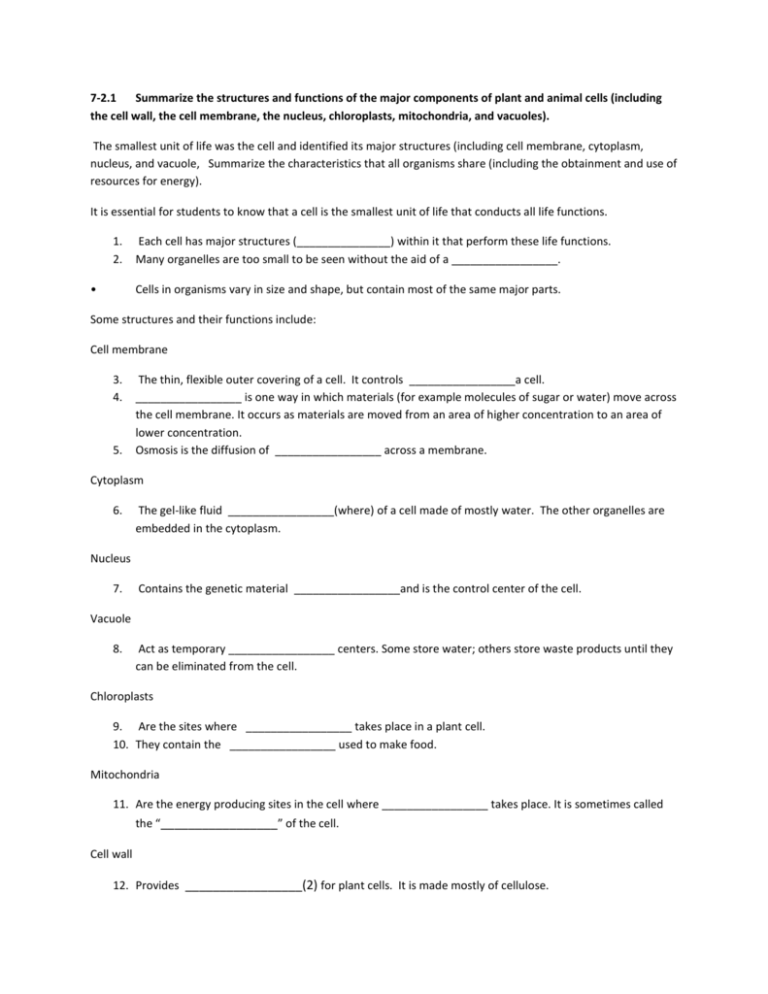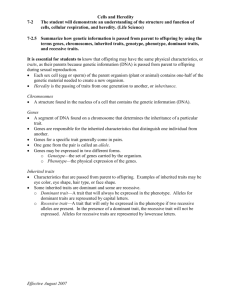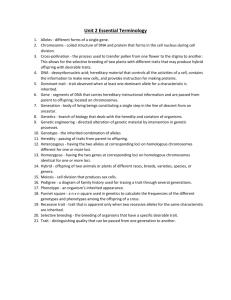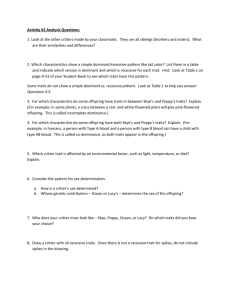7-2.1 Summarize the structures and functions of the major
advertisement

7-2.1 Summarize the structures and functions of the major components of plant and animal cells (including the cell wall, the cell membrane, the nucleus, chloroplasts, mitochondria, and vacuoles). The smallest unit of life was the cell and identified its major structures (including cell membrane, cytoplasm, nucleus, and vacuole, Summarize the characteristics that all organisms share (including the obtainment and use of resources for energy). It is essential for students to know that a cell is the smallest unit of life that conducts all life functions. 1. 2. • Each cell has major structures (_______________) within it that perform these life functions. Many organelles are too small to be seen without the aid of a _________________. Cells in organisms vary in size and shape, but contain most of the same major parts. Some structures and their functions include: Cell membrane 3. 4. 5. The thin, flexible outer covering of a cell. It controls _________________a cell. _________________ is one way in which materials (for example molecules of sugar or water) move across the cell membrane. It occurs as materials are moved from an area of higher concentration to an area of lower concentration. Osmosis is the diffusion of _________________ across a membrane. Cytoplasm 6. The gel-like fluid _________________(where) of a cell made of mostly water. The other organelles are embedded in the cytoplasm. Nucleus 7. Contains the genetic material _________________and is the control center of the cell. Vacuole 8. Act as temporary _________________ centers. Some store water; others store waste products until they can be eliminated from the cell. Chloroplasts 9. Are the sites where _________________ takes place in a plant cell. 10. They contain the _________________ used to make food. Mitochondria 11. Are the energy producing sites in the cell where _________________ takes place. It is sometimes called the “_________________” of the cell. Cell wall 12. Provides _________________(2) for plant cells. It is made mostly of cellulose. Assessment Guidelines: The objective of this indicator is to summarize the structures and functions of the major components of plant and animal cells; therefore, the primary focus of assessment should be to generalize the main points regarding the major functions of the cell structures (including cell wall, the cell membrane, the nucleus, chloroplasts, mitochondria, and vacuoles). However, appropriate assessments should also require students to identify individual parts of the cell or their functions; illustrate parts of the cell using words, pictures, or diagrams; classify the cell structures as either a structure in an animal cell or a plant cell; or explain the processes of diffusion and osmosis. 7-2.2 Compare the major components of plant and animal cells. 13. Even though all living organisms are made of cells that contain similar structures, there are _________________between the structures of the cells of plants and animals. 14. Structures that are common to plant and animal cells are the _________________ _________________(4) Structures that are specific to plants are the _________________and chloroplasts. Major structural differences between a plant and an animal cell include: 15. Plant cells have a _________________, but animal cells do not. Cell walls provide support and give shape to plants. Plant cells have chloroplasts, but animal cells do not. Chloroplasts enable plants to perform photosynthesis to make ______________________. 16. Plant cells usually have one or more large __________________(s), while animal cells have smaller vacuoles, if any are present. Large vacuoles help provide shape and allow the plant to store _________________ (2) for future use. The storage function plays a lesser role in animal cells, therefore the vacuoles are smaller. Assessment Guidelines: The objective of this indicator is to compare the major components of plant and animal cells; therefore, the primary focus of assessment should be to detect how the plant and animal cells structures are similar and different. However, appropriate assessments should also require students to identify the component parts of plant and animal cells; exemplify cell parts that perform specific functions in either plant or animal cells; illustrate plant and animal cells to indicate cell structures in each type of cell using pictures, words, or diagrams; or classify cells as either plant or animal based on their cell parts. 7-2.3 Compare the body shapes of bacteria (spiral, coccus, and bacillus) and the body structures that protists (euglena, paramecium, amoeba) use for food gathering and locomotion. 17. IDENTIFY bacteria by their shape euglena, paramecium amoeba 18. Identify protists (above), by the way they move and gather food. 19. Bacteria are organisms that are classified into the Kingdom _______________. They are all single-celled organisms. They are classified by their body ______________. 20. Spiral --____________-shaped bacteria are corkscrew shaped 21. Bacillus--__________-shaped bacteria 22. Coccus --___________-shaped bacteria 23. Protists are organisms that are classified into the Kingdom Protista. Although there is a lot of variety within the protists, they do share some common characteristics. Protists are usually one-celled organisms that live in all ________________ environments. They vary in the way they obtain food and move. Examples of protists include _____________________________(3) Euglena—Protist with Flagella 24. These protists move pulling themselves with long whip like structure called __________________. These protists can have one or more flagella that help them move. The euglena is unique in that it has characteristics of both a ____________________ (2), it contains chloroplasts that photosynthesize and also can consume other organisms as well. Paramecium—Protist with Cilia 25. These protists move by beating tiny hair-like structures called ________________. The cilia act as tiny oars that allow the protist to move through its watery environment. The cilia also move and help to ______________ directing in toward a groove that functions like a mouth. Amoeba—Protist with Pseudopods 26. These protists move by extending their bodies forward and then pulling the rest of their bodies forward as well. The finger-like structures that they project forward are called ________________ (false foot). The pseudopods are also used to trap ________________. Viruses 27. Viruses are tiny particles much _____________ than bacteria and can only be seen with a very powerful microscope. In isolation, viruses show none of the expected signs of life. They do not respond to stimuli, they do not grow; they do not do any of the things we normally associate with life. Therefore, they should not be considered as living organisms at all. However, viruses do show one of the most important signs of life: the ability to ___________________. Viruses are considered to be nonliving until they infect the cells of a host plant or animal and reproduce within those cells. 28. Viruses are responsible for causing many diseases in living organisms (for example __________________, colds, and flu in humans). 7-2.4 Explain how cellular processes (including respiration, photosynthesis in plants, mitosis, and waste elimination) are essential to the survival of the organism. 29. Because a cell is the smallest unit of life, it must undergo certain cellular processes in order to ensure the ________________of the organism as a whole. Some of the cellular processes that are essential include: Photosynthesis 30. Plants use light energy (for example sunlight) to combine carbon dioxide (CO2) and water (H2O) to make simple _____________ (C6H12O6). 31. Plant cells also release ________________ gas (O2). 32. Once the sugars are formed, they are either used by the plant or stored in the ________________. 33. Photosynthesis occurs in the ________________. Respiration 34. All organisms, including plants and animals, break down simple sugars (C6H12O6) into carbon dioxide (CO2) and water (H2O) and release ______________________. 35. The cell uses the energy to build, repair, and reproduce_________________. 36. Respiration occurs in the mitochondria of _________________. Waste elimination 37. Organisms rid the cells of waste products that could be ______________ to the cell. As waste particles accumulate in a cell, the waste will move out of the cell and be eliminated. 38. The waste particles will ______________ from a more concentrated area to a less concentrated area. Mitosis 39. Cell reproduction is called ______________ and occurs in the nucleus of the cell. Mitosis enables a cell to make an exact copy of it. 40. Mitosis is a process of cell division, which results in the production of __________ daughter cells from a single parent cell. The daughter cells are ___________ to one another and to the original parent cell. Mitosis is needed for growth, replacement, and asexual reproduction. 7-2.5 Summarize how genetic information is passed from parent to offspring by using the terms genes, chromosomes, inherited traits, genotype, phenotype, dominant traits, and recessive traits. 41. Offspring may have the same physical characteristics, or traits, as their parents because genetic information (DNA) is passed from ____________ to offspring during sexual reproduction. Each sex cell (egg or sperm) of the parent organism (plant or animal) contains ______________ of the genetic material needed to create a new organism. 42. Heredity is the passing of ___________ from one generation to another, or inheritance. Chromosomes 43. A structure found in the __________ of a cell that contains the genetic information (DNA). Genes 44. A segment of DNA found on a chromosome that determines the inheritance of a particular __________. Genes are responsible for the ____________ characteristics that distinguish one individual from another. 45. Genes for a specific trait generally come in ___________. One gene from the pair is called an allele. 46. Genes may be expressed in two different forms: _________________—the set of genes carried by the organism. _________________—the physical expression of the genes. Inherited traits 47. Characteristics that are passed from parent to offspring. Examples of inherited traits may be __________, eye shape, hair type, or face shape. 48. Some inherited traits are dominant and some are _________________. Dominant trait—A trait that will always be expressed in the phenotype. Alleles for dominant traits are represented by _________________ letters. Recessive trait—A trait that will only be expressed in the phenotype if two recessive alleles are present. In the presence of a dominant trait, the recessive trait will not be expressed. Alleles for recessive traits are represented by lowercase letters. 7-2.6 Use Punnett squares to predict inherited monohybrid traits. 49. Offspring inherit the genes for particular traits from their parents. Genes for a particular trait normally come in _________________. 50. Since each parent normally has two alleles for a single trait, we use a _________________ square to determine the possibilities of the combinations of alleles that the offspring may receive. 51. A Punnett square is a tool used to predict the ratio or percentage of the possible genes that an offspring will have based on the genes of the parent. 52. In a Punnett square, the top of the table shows the alleles provided by one _______________. The alleles for the other parent are placed along the ________side of the table. 53. One allele from each parent is placed in the individual squares, forming a new gene ________________. 54. For example, the following table shows the cross Tt x tt: • In this example, tallness (T) is the __________trait and shortness (t) is the recessive trait. 55. As the Punnett square shows, TT, Tt, and tt are all possible genotypes for the height of the offspring. The offspring with the genotypes TT and Tt will have a phenotype of __________; the offspring with the genotype of tt will have a phenotype of _________________. 56. If the two alleles are the same (TT or tt), the genotype is considered _________________. If the two alleles are different (Tt), the genotype is considered ________________. 57. This example shows the inheritance of a ____________________characteristic (height). A cross that shows the inheritance of a single characteristic is known as a monohybrid cross. It is sometimes difficult to predict certain traits in humans (for example hair color or eye color) because there may be several different genes that control these traits. 7-2.7 Distinguish between inherited traits and those acquired from environmental factors. 58. All characteristics that organisms have are inherited from their parents but some can be influenced by _____________________________. An inherited trait is a genetically determined characteristic that distinguishes one organism from another organism. Some inherited traits are dominant, some are recessive, and some are neither. 59. An example of an inherited trait in plants may be color of flowers. The color red is dominant over the recessive color white. Pink flowers are a result of a blending of red and white. Other examples of inherited traits may be the shape of seeds or leaves, or the height of the plant. An example in animals may be eye color. ____________ eye color is dominant over the recessive blue eye color. Green or hazel eyes are neither dominant nor recessive. Other examples of inherited traits may be body design, baldness, blood type, or skin color. 60. Physical characteristics of organisms may be influenced by environmental factors. Examples of environmental factors that can alter the phenotype of an organism may be ______________________________________________________________________________ ______________________________________________________________________________ ___________(6) 61. Temperature, for example, may affect the number or size of leaves in plants or the color or amount of fur or thickness of skin in animals. Nutrients, for example, may affect the growth or seed production in plants or the _____________ or height in animals. Injuries, for example, may cause _________- in plants and animals. Disease, for example, may affect the number of branches in plants or _____________ in animals. Exposure to sun, for example, may affect the __________ of leaves in plants or skin changes in animals. Living conditions, for example, may affect the leaves, roots and height in plants or the condition of fur, skin, or teeth in animals.









